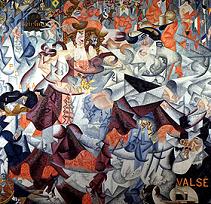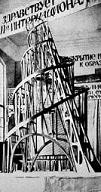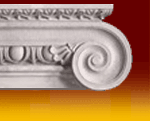|
Futurism was a movement in the early 20th Century, which disregarded traditions in art and lifestyle in favour of glorifying
contemporary life. In 1909 the Italian poet Filippo Tommaso Marinetti published a statement asserting the main principles
of Futurism, and in 1910 the Technical Manifesto of Futurist Painting was signed by Italian artists Gino Severini, Carlo Carrŕ,
Giacomo Balla, Luigi Russolo and Umberto Boccioni. 20th-Century machines were the main inspirations for Futurism, and bright
colours and flowing brush strokes were employed to create the illusion of movement. The movement lasted only until 1914, but
its influence is apparent in the works of Fernand Léger, Marcel Duchamp and Robert Delaunay, and its infatuation with the
machine was a strong characteristic of Fascist doctrine.

"Dynamic Hieroglyphic of the Bal Tabarin" (1912) - Gino Severini
This painting is characteristic of the Futurist attempt to simultaneously portray numerous actions and positions of subject
matter, vaguely giving the effect of a stroboscopic photograph (a photograph used to observe moving objects by making them
appear stationary) or a collage of photographs taken one after the other.

Constructivism was founded by a Russian sculptor named Vladimir Tatlin. The name derived from the idea of constructing abstract
sculptures from industrial materials like metal, wires and plastics. Its is apparent in mid-20th-Century architecture, sculpture
and industrial design. The first works of the movement were created by Tatlin from 1913 to 1917. By 1920 other artists, including
Aleksandr Rodchenko, El Lissitzky, Naum Gabo, and Antoine Pevsner had joined the movement.
In the 1920's Constructivism was divided into several different styles, but overall the movement was based on the ideals
of abstraction, functionalism and utilitarianism. The themes of the design of Constructivist sculptures were often geometric
and mechanical, few of the artworks conveying any emotional significance. Utilitarianism was then the predominant disposition
towards art in the Union of Soviet Socialist Republics, and held that artworks should be easily comprehensible and socially
useful. Tatlin became a powerful and influential designer when he merged the values of Constructivism with those of the new
Communist state. Constructivism was active until the 1940's.
Back
|

